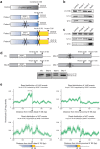SRSF1 suppresses selection of intron-distal 5' splice site of DOK7 intron 4 to generate functional full-length Dok-7 protein
- PMID: 28874828
- PMCID: PMC5585400
- DOI: 10.1038/s41598-017-11036-z
SRSF1 suppresses selection of intron-distal 5' splice site of DOK7 intron 4 to generate functional full-length Dok-7 protein
Abstract
Dok-7 is a non-catalytic adaptor protein that facilitates agrin-induced clustering of acetylcholine receptors (AChR) at the neuromuscular junction. Alternative selection of 5' splice sites (SSs) of DOK7 intron 4 generates canonical and frame-shifted transcripts. We found that the canonical full-length Dok-7 enhanced AChR clustering, whereas the truncated Dok-7 did not. We identified a splicing cis-element close to the 3' end of exon 4 by block-scanning mutagenesis. RNA affinity purification and mass spectrometry revealed that SRSF1 binds to the cis-element. Knocking down of SRSF1 enhanced selection of the intron-distal 5' SS of DOK7 intron 4, whereas MS2-mediated artificial tethering of SRSF1 to the identified cis-element suppressed it. Isolation of an early spliceosomal complex revealed that SRSF1 inhibited association of U1 snRNP to the intron-distal 5' SS, and rather enhanced association of U1 snRNP to the intron-proximal 5' SS, which led to upregulation of the canonical DOK7 transcript. Integrated global analysis of CLIP-seq and RNA-seq also indicated that binding of SRSF1 immediately upstream to two competing 5' SSs suppresses selection of the intron-distal 5' SS in hundreds of human genes. We demonstrate that SRSF1 critically regulates alternative selection of adjacently placed 5' SSs by modulating binding of U1 snRNP.
Conflict of interest statement
The authors declare that they have no competing interests.
Figures






Similar articles
-
SRSF1 and hnRNP H antagonistically regulate splicing of COLQ exon 16 in a congenital myasthenic syndrome.Sci Rep. 2015 Aug 18;5:13208. doi: 10.1038/srep13208. Sci Rep. 2015. PMID: 26282582 Free PMC article.
-
Exon-independent recruitment of SRSF1 is mediated by U1 snRNP stem-loop 3.EMBO J. 2022 Jan 4;41(1):e107640. doi: 10.15252/embj.2021107640. Epub 2021 Nov 15. EMBO J. 2022. PMID: 34779515 Free PMC article.
-
Splicing Enhancers at Intron-Exon Borders Participate in Acceptor Splice Sites Recognition.Int J Mol Sci. 2020 Sep 8;21(18):6553. doi: 10.3390/ijms21186553. Int J Mol Sci. 2020. PMID: 32911621 Free PMC article.
-
How Are Short Exons Flanked by Long Introns Defined and Committed to Splicing?Trends Genet. 2016 Oct;32(10):596-606. doi: 10.1016/j.tig.2016.07.003. Epub 2016 Aug 6. Trends Genet. 2016. PMID: 27507607 Review.
-
An active role for splicing in 3'-end formation.Wiley Interdiscip Rev RNA. 2011 Jul-Aug;2(4):459-70. doi: 10.1002/wrna.68. Epub 2010 Dec 16. Wiley Interdiscip Rev RNA. 2011. PMID: 21957037 Review.
Cited by
-
Splicing regulation of GFPT1 muscle-specific isoform and its roles in glucose metabolisms and neuromuscular junction.iScience. 2023 Aug 26;26(10):107746. doi: 10.1016/j.isci.2023.107746. eCollection 2023 Oct 20. iScience. 2023. PMID: 37744035 Free PMC article.
-
Tethered Function Assays to Elucidate the Role of RNA-Binding Proteins.Methods Mol Biol. 2022;2537:285-306. doi: 10.1007/978-1-0716-2521-7_17. Methods Mol Biol. 2022. PMID: 35895271
-
DOK7 Gene Novel Homozygous Mutation is Related to Fetal Akinesia Deformation Sequence 3.J Obstet Gynaecol India. 2025 Apr;75(Suppl 1):592-598. doi: 10.1007/s13224-023-01827-y. Epub 2023 Nov 15. J Obstet Gynaecol India. 2025. PMID: 40390963
References
-
- Ohno, K. et al. Splicing regulation and dysregulation of cholinergic genes expressed at the neuromuscular junction. Journal of Neurochemistry (2017). - PubMed
Publication types
MeSH terms
Substances
LinkOut - more resources
Full Text Sources
Other Literature Sources

